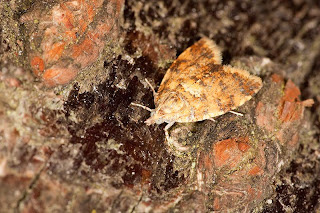Moth species count 53
Total moth count 124
A reasonable night. New to the garden was the yellow shell. A broad-bordered yellow underwing was the first of the year, as was a common rustic. There were 2 Mother of Pearl micromoths that were firsts for the year.
 Common emerald (Hemithea aestivaria)
Common emerald (Hemithea aestivaria)A single generation moth flying late June to late July. It flies from dusk visiting flowers after dark, such as wild privet and creeping thistle. Its habitat is woodlands, hedgerows, scrub on heathland and downland, and gardens.


Marbled minor (Oligia strigilis)
Yellow shell (Camptogramma bilineata)
 Double square-spot (Xestia triangulum)
Double square-spot (Xestia triangulum)This is a rather pale example. It is a single generation moth that flies from June to early August. It is common throughout Britain and is found in deciduous woodland, hedgerows and gardens.
 Large yellow underwing (Noctua pronuba)
Large yellow underwing (Noctua pronuba)This is one of the commonest moths in summer and its numbers are now noticably increasing with 21 in the trap this morning. It flies from June to October or November. It is ubiquitous and common th roughout Britain.

 Flame shoulder (Ochropleura plecta)
Flame shoulder (Ochropleura plecta) Common wainscot (Mythimna pallens)
Common wainscot (Mythimna pallens) Broad-bordered yellow underwing (Noctua fimbriata)
Broad-bordered yellow underwing (Noctua fimbriata)This moth flies between July and September. It emerges in July and then hides until August/September. It is found in wooded areas and in limited numbers in gardens throughout mainland Great Britain.



Plum tortrix (Hedya pruniana)
Small magpie (Eurrhypara hortulata)


Lozotaenia forsterana
The largest tortrix. It flies in June and July when it is common in parks, gardens and woods.
 Mother of Pearl (Pleuroptya ruralis)
Mother of Pearl (Pleuroptya ruralis)


Male yellow tail (Euproctis similis)
The black dot on the forewing identifies this as a male. The female is all white. Its yellow tail is displayed when it feels threatened.






No comments:
Post a Comment